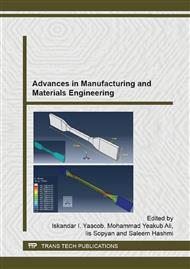[1]
P. K Sahoo, P. K Rana, D. B Sarker, A. Sahoo, and S. K Swain: characterization and properties of chemically modified corchorus capsularis jute fibre via pulping and grafting: infrared, thermogravimetric analysis, differential scanning calorimetry, Scanning electron microscopy, X-ray diffraction, biodegradation & superabsorbency. J. Polym. Sci Pt. A: Polym. Vol. 41 (2003).
DOI: 10.1002/pola.10813
Google Scholar
[2]
Dr. Nitin Jain, MOON Banerjee and Shubhashish Sanyal: Effect of Fiber Length Variations on Properties of Coir Fiber Reinforced Cement-Albumen Composite (CFRCC), IIUM Engineering Journal. Vol. 12 (2012).
DOI: 10.31436/iiumej.v12i1.116
Google Scholar
[3]
S. M. Kashif, Mohd Sultan Ibrahim, M. Abdur Razzak, M. Azram: Study of the effect of different curing setups on mechanical properties of low cost composite structures, ICMAAE-2013, 2-4 July 2013, Kuala Lumpur, Malaysia.
Google Scholar
[4]
F. A Silva, N. Chawla, R.D. T Filho: Tensile behavior of high performance natural (sisal) fibers. Composites Science and Technology. Vol. 68 (2008), pp.3438-3443.
DOI: 10.1016/j.compscitech.2008.10.001
Google Scholar
[5]
M.E. A Fidelis, T.V. C Pereira, O.F. M Gomes, F.A. Silva, and R.D. T Filho: The effect of fiber morphology on the tensile strength of natural fibers, Journal of Materials Research and Technology. Vol. 2 (2013), pp.149-157.
DOI: 10.1016/j.jmrt.2013.02.003
Google Scholar
[6]
A. Belaadi, A. Bezazi, M. Bourchak and F. Scarpa: Tensile static and fatigue behavior of sisal fibers . Materials and Design, vol. 46 (2013), pp.76-83.
DOI: 10.1016/j.matdes.2012.09.048
Google Scholar
[7]
Z. Ahmad, I.I. S Sopyan , Z. Halim, N. Sarifuddin: A Linear Relationship between the Mechanical, Thermal and Gas Barrier Properties of MAPE Modified Rubber Toughened Nanocomposites , IIUM Engineering Journal. Vol. 11 (2010).
DOI: 10.31436/iiumej.v11i2.114
Google Scholar
[8]
W. Weibull: A statistical distribution function of wide applicability, Journal of Applied Mechanics. vol. 18 (1951), p.293.
Google Scholar


